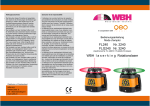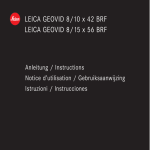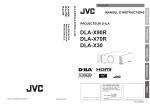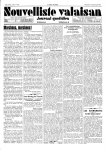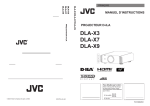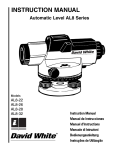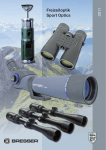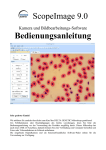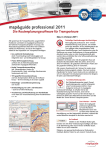Download BINOCOM 7x50
Transcript
ANL1866805MSP0607BRESSER 28.06.2007 15:47 Uhr Seite 1 Gebrauchsanweisung Instruction for use Mode d’emploi BINOCOM 7x50 ANL1866805MSP0607BRESSER 28.06.2007 15:47 Uhr Seite 2 Teileverzeichnis / Key to parts / Description: BINOCOM 7x50 EinzelokularEinstellung Separate eyepiece focussing Reglageivuel sur oculaire Gummiaugenmuschel Rubber eyecups Caouchouc oculaire Kompass Compass Boussoie Batteriefach Battery compartment Compartiment à piles Ein/Aus Schalter für Kompassbeleuchtung On/Off switch for compass illumination Interrupteur de lumière ANL1866805MSP0607BRESSER 28.06.2007 15:47 Uhr Abb. A 350 360 10 DE GEBRAUCHSANLEITUNG Einstellen des Augenabstands: Der Abstand der Augen variiert von Person zu Person. Um ein perfektes Zusammmenspiel zwischen Ihren Augen und dem Okularen des Fernglases zu erreichen, sollten Sie das Fernglas vor Ihre Augen halten und den Abstand der beiden Okulare durch Zusammen- oder Auseinanderschieben so verändern, daß Sie ein klares Sehfeld erhalten. Scharfeinstellung: Ihr Fernglas ist mit einer EinzelokularEinstellung ausgestattet. Stellen Sie durch Drehen der beidseitigen Dioptrie-Einstellung Ihr Fernglas auf ein weiter entferntes Objekt scharf ein. Die Einzelokular-Einstellung ist auf eine größere Tiefenschärfe ausgerichtet, so dass Sie beim Wechsel auf unterschiedlich weit entfernte Objekte die Schärfe nur bei großen Entfernungsunterschieden nachstellen müssen. Umstülpen der Augenmuscheln: Wichtig für Brillenträger: Für Beobachtungen mit einer Brille werden die Gummiaugenmuscheln umgestülpt. So wird das ganze mögliche Gesichtsfeld des Fernglas-Modells ausgenutzt. Seite 3 Kompass Blicken Sie durch das Fernglas und Sie sehen eine Skala mit Gradangaben (350, 360, 10). Diese Skala ist ein beleuchteter 360° Kompass, wenn Sie in der Mitte der Skala 360° ablesen können, blicken Sie exakt nach Norden (Süd = 180°). Kompassbeleuchtung: Bei Dunkelheit können Sie die Kompassbeleuchtung einschalten, drücken Sie auf den Ein/Aus Schalter und die Kompassbeleuchtung ist solange eingeschaltet, wie Sie den Schalter gedrückt halten. Batteriewechsel: Öffnen Sie das Battriefach mit einer Münze und wechseln Sie die Batterie bei schwächer werdender Beleuchtung aus. Achten Sie dabei auf die Polung. Benutzung der Strichplatte (Abb. A): Entfernungsberechnung: Um die Entfernung eines Objektes bestimmen zu können, ist es notwendig, dessen Größe zu kennen. Peilen Sie das gewünschte Objekt an und lesen Sie die Anzahl der einzelnen Striche auf der Strichplatte ab. Teilen Sie nun die Größe durch die Anzahl der abgelesenen Striche, multipliziert mit 5. Das Ergebnis multiplizieren Sie mit 1.000. Sie erhalten die Entfernung zum Objekt in Meter. Beispiel: Ein Turm hat eine Anzahl von 6 Strichen auf der Strichplatte und eine bekannte Höhe von 60 m. Die Entfernung beträgt: (60 : (6 x 5)) x 1.000 = 2.000 m Größenbestimmung: Um die Größe eines Objektes bestimmen zu können, ist es notwendig, dessen Entfernung zu kennen. Peilen Sie das gewünschte Objekt an und lesen Sie die Anzahl der einzelnen Striche auf der Strichplatte ab. Die Entfernung multiplizieren Sie mit der Anzahl der abgelesenen Striche und dann mit 5. Das Ergebnis dividieren Sie durch 1.000. Beispiel: Ein Turm hat eine Entfernung von 2.000 m und es werden 6 Stricheinteilungen auf der Skala abgelesen. Die Höhe beträgt: ((2.000 x 6) : 1.000) x 5 = 60 m ANL1866805MSP0607BRESSER 28.06.2007 15:47 Uhr Reinigen des Fernglases: 1. Entfernen Sie grobe Staubpartikel mit einem Pinsel. 2. Benutzen Sie für die weitere Reinigung bitte ein weiches, fusselfreies Reinigungstuch. 3. Falls noch Schmutzreste auf den Linsen bleiben, feuchten Sie das Tuch mit etwas reinem Alkohol (Spiritus). Die Reinigung sollte ohne starken Druck erfolgen. GB INSTRUCTION FOR USE Adjust the distance between your eyes: The distance between the eyes, called "interpupillary distance" varies from person to person. To achieve perfect aligament of lens to eye hold your binoculars in the normal viewing position. Grasp each barrel firmly. Move the barrels closer together or further apart until you see a single circular field. Always re-set your binoculars to this position before using. Focusing: 1. Look into the lens without graduation scale (usually the left turbe) and close your right eye. 2. Turn the separate eyepiece focussing and adjust the sharpness of the object by changing the focal distance. 3. Next focus the other lens (with the other eye) on the subject by turning the dioptre adjustment until sharp image is achieved. Compass Looking through this binocular you shall see a scale with degrees (350, 360, 10). This scale is an illuminated 360° compass. Qnce you see 360° in the centre of the scale you are looking sharply to the northern compass point. Compass light: Whilst you are pressing the button the lighting of the compass turns on, by releasing the button it turns off. Seite 4 Changing the Battery: You change the battery once the lighting weakens. Please use a coin to unscrew the battery compartment and change the battery. Make sure that you have inserted the battery correctly. Using the reticle (Abb. A): Determing the distance: To be able to detremine the distance of an object you need to know its size. Take a bearing on the object you wish to look at and read off the number of lines on the reticle. Now divide the size by the number of lines multiplied by five. Multiply the result by 1,000 to give you the distance from the object in metres. Example: A Tower has 6 lines on the reticle and a known height of 60 m. The distance is: (60 : (6 x 5)) x 1.000 = 2.000 m Determing the size: To be able to determine the size of an object you need to know its distance. Take a bearing on the object you wish to look at and read off the number of lines on the reticle. Multiply the distance by the number of lines and multiply that figure by five. Divide the result by 1,000. Example: A tower has a distance of 2,000 m and 6 lines appear on the scale. The height is: ((2,000 x 6) : 1.000) x 5 = 60 m Fold down eyecups: If you wear sun/eyeglasses, fold down the eyecups . This will bring eyes closer to the lens thus providing an improved field of view. Cleaning: 1. Blow away any dust or debris on the lens (or use a soft lens brush). 2. To remove dirt or fingerprints, clean with a soft cotton cloth rubbing in a circular motion. Use of a coarse cloth or unnecessary rubbing may scratch the lens surface and eventually cause permanent damage. ANL1866805MSP0607BRESSER 28.06.2007 15:47 Uhr 3. For a more thorough cleaning, photographic-type lens cleaning fluid may be used. Always apply the fluid to the cleaning cloth, never directly onto the lens. FR MODE D’EMPLOIE Comment ajuster votre jumelle par rapport a vos yeux: La distance entre l’oeil et la jumelle se nomme „distance interpupilaire“. Cette distance varie d’une persone à l’autre. Il est nécessaire d’ajuster parlaitement la jumelle par rapport aux yeux seion les indications ci-dessous: 1. Prenez votre jumelle dans une position normale pour observer. 2. Ecarter ou rappoche les corps justique à ce que vous ne voyez plus qu’un seui cercle. Veullez ersuite toujours metre votre jumelle dans cetto position avant de l’utiliser. Utilisation: 1. Regarder à travers l’oculaire quin’a pas de graduation (habituellement oculaire gauche) et fermer votre oeil droit. 2. Tourner la reglage individuel sur oculaire attr. d’ajuster la netteté de l’image. 3. Ouvir l’oeil droit et ajuster la netteté de l’image de l’oculaire droit en tournant le réglage dioptrique jusqu à observer une image nette. Ne pas toucher à la reglage individuel sur oculaire pendant cette opération. Bonnette oculaires caoutchouc: Si vous portez des lunettes de vue, ecaoutchouc de la bonnette doil etre replié . A’nsi, votre lunette se trouvera le plus pres possible de la lentille oculaire et vous permettra de bénéficer du maximum de champ de vision. Boussole Vous pouvez lire votre boussole dans la nuit grace à une lumière rouge en pres- Seite 5 sant le bouton . Si la lumière faiblit, changez les piles. Pour cela utilisez une pièce, devissez le couvercle du compartiment à piles , changez le piles et assurez vous que ces piles so ent correctement positionnees. Notes: 360° = nord / 180° = sud / ... Réticale gradué (Abb. A): Distance: Vous désirez savoir quelle distance vous sépare d‘une cóte, d’un phare, d’un montage, c’un baleau, etc. Vous connaissez la hauteur de l’object. Maintenez les jumelles horizonailement. Lisez, sur le trail vertical du réticule, le nombre correspondant au sommel ce l’objet par le nombre du réticule. Multipliez le résultat per 1000. Vous connaissez la longueur de l’objet (distance entre 2 phares, longuer d’un bareau, etc.) Meme calcut que précedemment mals en isant les graduatons horizontales du Hauteur ou Longuer Graduation x 1000 Dimension: Vous désirez comaltre la dimension d’ur objet et wois savez quelle distance vous en sépare. Pour en connaitre la hauteur. Maintenez les jumelles horizontalement. Lisez, sur le trait vertical du réticule, le nombre correspondant au sommel de l’objet. Multipliez la distance connue par la nombre du réticule. Divisez le résultat par 1000. Pour en connaitre la longueur. Méme clcu’ que précefemment mais en isant les graduations horizontales du réticule. En résumè: Hauteur ou Longueur = Distance x Graduation 1000 Entretien: Poussières etimmer la poussière à l’aide d’une brosse spéciale photo et employer un chiffon en coton afin d’essuyer les empruntes digitales. Ne jamais mettre de produit sur lentilles (oculaires ou objectis). En cas de corps gras, imbioer légèrement d’alcool pur votre chiffon en coton avant d’essuyer. ANL1866805MSP0607BRESSER 28.06.2007 15:47 Uhr Seite 6 ANL1866805MSP0607BRESSER 28.06.2007 15:47 Uhr Seite 7 15:47 Uhr Seite 8 Technische Änderungen vorbehalten. Reservation of technical alterations. Sous réserve de modifications techniques. 28.06.2007 ANL1866805MSP0607BRESSER ANL1866805MSP0607BRESSER Meade Instruments Europe GmbH & Co. KG Gutenbergstr. 2 · DE-46414 Rhede www.bresser.de · [email protected]









